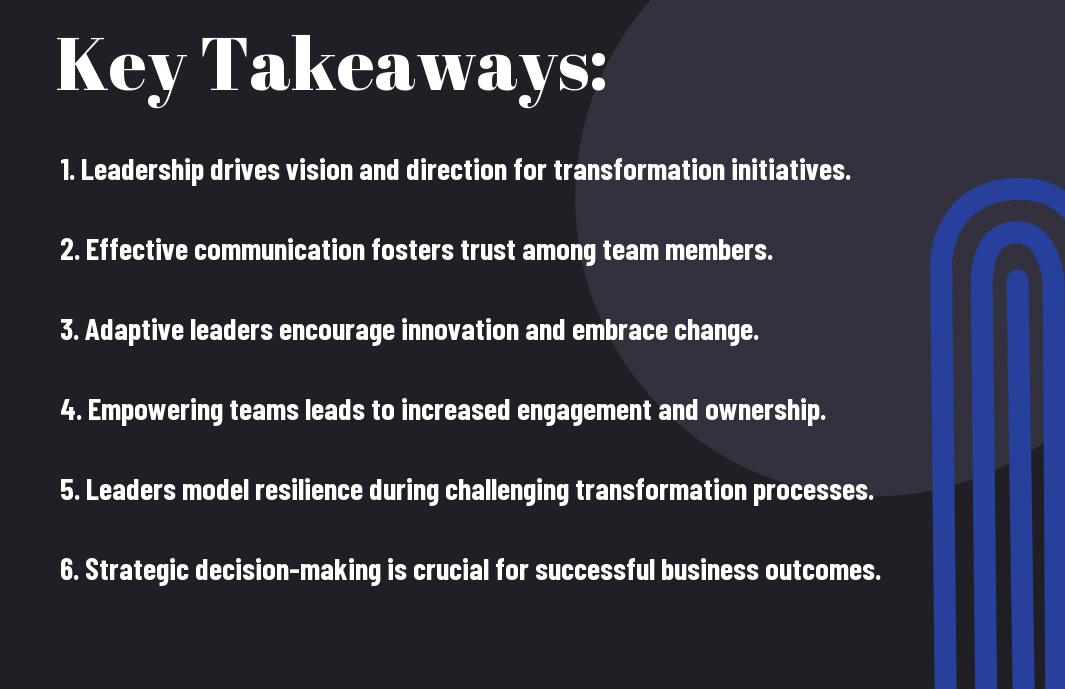
Most effective business transformations hinge on strong leadership. As you navigate the complexities of change, your role as a leader becomes pivotal in guiding your team and organization through uncertainty. Effective leadership not only inspires your workforce but also aligns your vision with actionable strategies. This post will explore how you can harness your leadership capabilities to drive successful transformation and create a culture that embraces change, ultimately enhancing your organization’s resilience and competitiveness in today’s dynamic market.

Understanding Business Transformation
Your journey into business transformation begins with a clear understanding of what it entails. This process represents a fundamental shift in how your organization operates, driving significant changes across strategy, processes, culture, and technology. Embracing transformation can lead to improved efficiency, customer satisfaction, and competitive advantage, ultimately aligning your business with evolving market demands.
Definition and Importance
Along your path to transformation, it’s crucial to grasp its definition and importance. Business transformation refers to the comprehensive overhaul of operations, including alterations in technology, processes, and people, aimed at achieving long-term growth and sustainability. Understanding its significance enables you to appreciate how these changes can enhance performance, boost innovation, and foster agility in a rapidly changing business landscape.
Key Drivers of Transformation
Definition of key drivers involves recognizing the significant factors that compel your organization to pursue transformation. These drivers include advancements in technology, evolving consumer expectations, competitive pressures, regulatory changes, and the need for operational efficiency. By identifying these elements, you can better understand the motivations behind your business’s transformation journey.
In fact, the key drivers of transformation are interconnected and reflect the broader shifts occurring within your industry. For example, rapid technological advancements often lead to demands for more efficient processes, while heightened customer expectations push businesses to innovate their offerings continually. Additionally, competitive pressures can necessitate transformation to maintain relevance, and regulatory changes may require adaptations to comply with new standards. Recognizing these drivers is crucial for formulating a successful transformation strategy.
Leadership Characteristics for Successful Transformation
Now, as a leader navigating the waters of business transformation, you must embody certain characteristics that facilitate change. These attributes include adaptability, decisiveness, and resilience, enabling you to guide your team through challenges and uncertainties. Your capacity to inspire and motivate others fosters a collaborative environment important for successful transformation initiatives.
Visionary Leadership
Transformation begins with your ability to articulate a clear and compelling vision for the future. This visionary leadership provides direction and purpose, driving your team to align their efforts toward achieving transformative goals. By sharing your insights and aspirations, you empower your colleagues to embrace innovation and adapt within a rapidly changing landscape.
Emotional Intelligence
To lead effectively during transformation, you must harness the power of emotional intelligence. This ability allows you to recognize, understand, and manage your emotions, as well as empathize with the emotions of others. By developing emotional intelligence, you create a supportive atmosphere that encourages open communication and builds trust within your team.
Intelligence in emotional contexts involves active listening, conflict resolution, and relationship building. As you cultivate these skills, you foster an environment where team members feel valued and understood. This not only enhances collaboration during the transformation process but also encourages innovation and adaptability, both important in achieving your business objectives.
The Role of Communication in Leadership
Many leaders underestimate the importance of effective communication during business transformation. Clear communication helps foster understanding, align goals, and encourages a shared vision among team members. By articulating your expectations and feedback openly, you create a culture of collaboration, where your team feels empowered to contribute ideas and address challenges together. This continuous dialogue not only enhances engagement but also strengthens the overall transformation process, ensuring that everyone is on the same page and working towards common objectives.
Transparency and Trust
Across successful organizations, transparency plays a key role in building trust between leaders and team members. By sharing your plans, challenges, and successes openly, you invite your team to be part of the journey, fostering a deeper connection. When your team knows they can trust you to provide honest updates, they feel more secure in their roles and are more likely to commit to the transformation efforts. This level of openness cultivates loyalty and motivates your team to work together toward shared goals.
Engaging Stakeholders
Role of effective stakeholder engagement cannot be overstated in the transformation process. Actively involving key players and ensuring their voices are heard allows you to navigate complexities more smoothly. Engaging stakeholders not only helps you identify potential obstacles early but also fosters a sense of ownership and accountability among team members, creating a unified approach to transformation.
It is necessary to involve stakeholders from all levels of your organization, as their perspectives can provide valuable insights into how changes impact various departments and processes. By conducting regular check-ins, soliciting feedback, and encouraging participation in decision-making, you not only enhance their investment in the transformation but also create a support system that will help drive success. When stakeholders feel valued and engaged, they are more likely to advocate for the change and work collaboratively towards its realization.
Strategic Decision-Making in Transformation
Unlike traditional management approaches, strategic decision-making in business transformation requires a forward-thinking mindset. You must analyze market trends, anticipate challenges, and seize opportunities for innovation. It’s necessary to foster a culture of collaboration, where insights from diverse perspectives guide your decisions. By integrating agility and adaptability into your strategy, you position your organization to thrive in a constantly evolving landscape.
Risk Management
Behind every successful transformation lies a robust risk management plan. You should assess potential uncertainties and formulate strategies to mitigate them. This proactive approach not only safeguards your organization against setbacks but also empowers you to make informed decisions. By embracing a comprehensive risk management framework, you enhance your resilience and ensure the sustainability of your transformation efforts.
Resource Allocation
With effective resource allocation, you can optimize outcomes during transformation. It’s necessary to evaluate your organization’s capabilities, needs, and goals to ensure strategic alignment. By prioritizing resources toward initiatives that deliver the most value, you can maximize efficiency and minimize waste. This fine-tuning of resources is vital for fostering innovation and supporting employees throughout the transformation journey.
Strategic resource allocation is about more than just distributing funds; it involves aligning human, technological, and operational resources with your transformation goals. You need to identify key projects that drive your vision forward and ensure that the right talent is in place to execute these initiatives. By continuously monitoring performance and adjusting allocations as necessary, you foster an environment where transformation can flourish, helping you achieve success in your strategic objectives.
Building a Culture of Innovation
For businesses to thrive in today’s dynamic environment, cultivating a culture of innovation is necessary. This not only encompasses adapting to technological advancements but also means fostering an atmosphere that encourages new ideas and approaches. Leaders play a pivotal role in this transformation, as your commitment to innovation can motivate your team to explore uncharted territories, ultimately enhancing organizational resilience and growth.
Fostering Team Collaboration
At the heart of innovation lies team collaboration, which facilitates the sharing of diverse perspectives and ideas. By creating cross-functional teams, you can break down silos and foster a sense of community among your employees. This collaboration encourages open dialogue, allowing innovative ideas to flourish and ultimately transforms the workplace into a hub of creativity.
Encouraging Creativity and Experimentation
At the same time, promoting an environment where creativity and experimentation are welcomed is vital. By supporting your team to take calculated risks and explore new solutions, you demonstrate that innovation is valued within your organization. This approach not only empowers employees but also leads to breakthroughs that can redefine your business strategies.
For instance, providing opportunities for hackathons or brainstorming sessions can stimulate spontaneous idea generation. When you encourage team members to explore their passions, they are more likely to engage in creative thinking. This practice can lead to unexpected innovations that align with your business goals and set you apart from competitors. Ultimately, by celebrating both success and failure, you build a culture where experimentation thrives, fostering a lasting commitment to innovation within your organization.
Measuring Leadership Impact on Transformation
Not all leadership strategies yield immediate results, making it necessary to measure their impact on your business transformation. By establishing clear metrics and feedback systems, you can better understand how your leadership decisions influence your organization’s progress. Analyzing this data allows you to fine-tune your approach, ensuring that your leadership effectively drives transformation and aligns with your strategic goals.
Performance Metrics
Below is a range of performance metrics you may consider for assessing leadership impact on transformation. Metrics such as employee engagement scores, project completion rates, and financial performance indicators provide quantitative measures. Additionally, tracking customer satisfaction and market share can help you gauge the broader effects of your leadership on your organization’s transformation journey.
Feedback Mechanisms
Impact your leadership effectiveness by implementing robust feedback mechanisms. Actively seeking input from your team ensures you capture diverse perspectives, identifying strengths and areas for improvement in your transformation efforts. Regular surveys, one-on-one check-ins, and anonymous suggestion boxes foster open communication and create an environment where employees feel heard, thus enhancing overall engagement and commitment to change.
At this stage, it’s vital to create a structured approach for collecting and analyzing feedback. Using tools like pulse surveys and performance reviews can systematically gather valuable insights. Consider integrating platforms where your team can share real-time feedback on leadership effectiveness and transformation initiatives. This collected data not only informs your leadership strategy but also strengthens your team’s trust and collaboration during the transformation process.
Final Words
Upon reflecting on the role of leadership in business transformation, you can see that effective leadership is your guiding force in navigating change. It is necessary for setting a clear vision, engaging your team, and fostering a culture of adaptability. By leveraging your leadership skills, you can inspire innovation and ensure that all stakeholders remain aligned during challenging transitions. Ultimately, your ability to motivate and empower others will be the key to not just surviving but thriving in an ever-evolving business landscape.
Leave a Reply